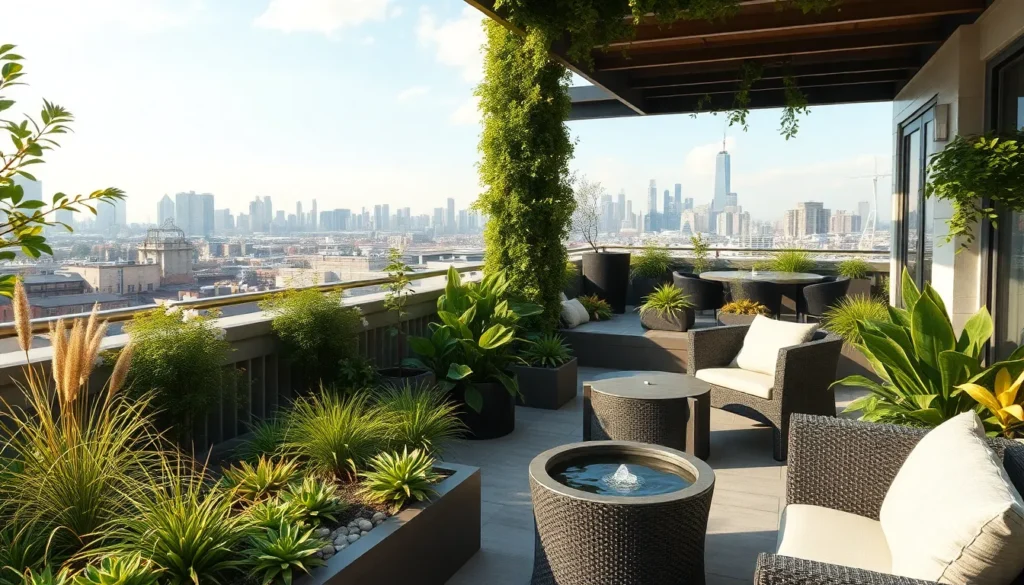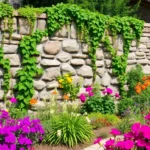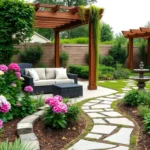Transforming your rooftop into a thriving garden isn’t just a trend – it’s a smart solution for urban living that maximizes every square foot of your property. We’ve discovered that roof gardens offer incredible benefits beyond just beautiful views, from reducing energy costs to creating your own private oasis above the city noise.
Whether you’re working with a sprawling rooftop or a compact balcony space, we’ll show you how to turn that unused area into a productive and stunning garden retreat. From selecting the right plants that can handle wind and sun exposure to designing clever storage answers, there’s a roof garden style that’ll work perfectly for your space and budget.
Ready to elevate your gardening game? We’ve compiled the most practical and inspiring roof garden ideas that’ll transform your outdoor space into something extraordinary while adding real value to your home.
Choose the Right Plants for Your Rooftop Environment
Plant selection determines the success of your rooftop garden transformation. Rooftop conditions present unique challenges that differ significantly from ground level gardening environments.
Select Wind-Resistant Varieties
Sturdy stems and flexible branches help plants withstand rooftop wind exposure that can reach speeds 20-30% higher than ground level. Ornamental grasses like fountain grass and blue fescue bend gracefully without breaking during strong gusts. Evergreen shrubs such as juniper and boxwood develop dense root systems that anchor them securely against wind damage.
Low-growing perennials create natural windbreaks while adding visual appeal to your rooftop garden design. Sedum varieties spread horizontally and grip surfaces tightly with their succulent foliage. Creeping thyme and ajuga form thick mats that resist wind uplift while producing colorful seasonal blooms.
Compact fruit trees on dwarf rootstocks perform exceptionally well in windy rooftop conditions compared to their full-sized counterparts. Dwarf apple varieties like Honeycrisp and Gala maintain productivity while staying under 8 feet in height. Espalier training techniques allow you to grow pear and cherry trees flat against walls for additional wind protection.
Opt for Drought-Tolerant Species
Water-storing capabilities make succulents perfect candidates for rooftop gardens where irrigation systems may face limitations. Agave plants store moisture in thick leaves and require watering only once every 2-3 weeks during growing season. Echeveria rosettes and jade plants thrive in containers with minimal water input while providing architectural interest.
Native wildflowers adapt naturally to local climate conditions and reduce maintenance requirements significantly. Black-eyed Susan and purple coneflower bloom continuously from summer through fall with weekly watering schedules. Prairie grasses like little bluestem and buffalo grass establish deep root systems that access moisture efficiently.
Mediterranean herbs combine culinary value with exceptional drought resistance for practical rooftop gardening answers. Rosemary and thyme plants produce aromatic foliage while surviving on rainfall alone in most climates. Lavender varieties attract beneficial pollinators and require watering only during extended dry periods exceeding 10 days.
Consider Sun and Shade Requirements
Full sun exposure characterizes most rooftop environments with 6-8 hours of direct sunlight daily throughout growing seasons. Tomato plants and pepper varieties maximize fruit production under intense rooftop sun conditions. Sunflower cultivars and marigold flowers thrive in high-heat environments while adding vibrant colors to container arrangements.
Partial shade answers work effectively for rooftops with building shadows or overhead structures limiting light exposure. Hostas and coral bells develop rich foliage colors in areas receiving 3-4 hours of morning sunlight. Begonia varieties and impatiens produce continuous blooms throughout summer months in filtered light conditions.
Microclimates develop naturally across rooftop surfaces due to building orientations and nearby structures affecting light patterns. South-facing areas receive maximum solar exposure ideal for heat-loving vegetables like eggplant and okra. North-facing sections provide cooler conditions suitable for lettuce crops and herb gardens that bolt quickly in excessive heat.
Create Functional Seating and Entertainment Areas
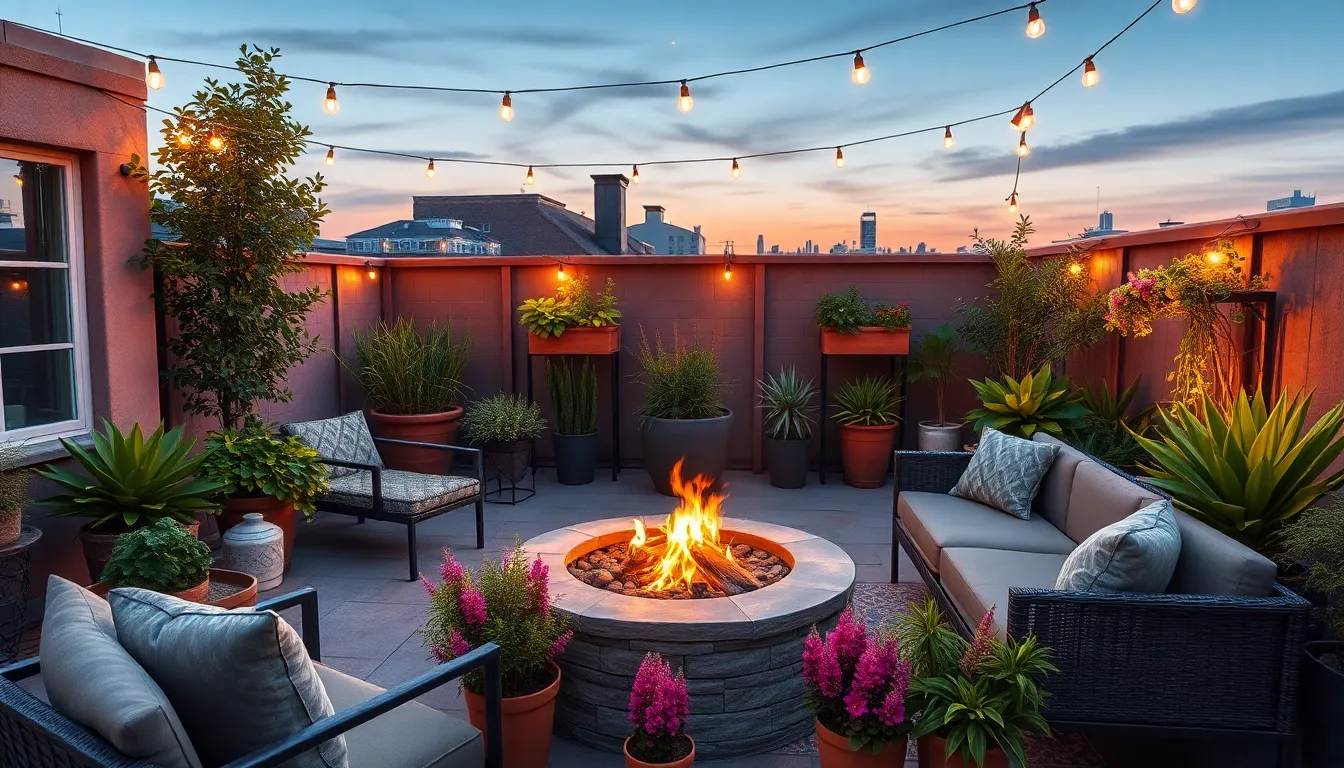
Once you’ve selected the perfect plants for your rooftop garden, it’s time to focus on creating comfortable spaces where you can truly enjoy your elevated oasis.
Install Weather-Resistant Outdoor Furniture
Choose furniture made from durable materials like metal, wood, or synthetic wicker to ensure your rooftop seating withstands harsh weather conditions. We recommend investing in pieces specifically designed for outdoor use, as they’ll maintain their appearance and functionality for years to come.
Wicker and recycled plastic furniture offer excellent weather resistance while providing the comfort you need for extended relaxation sessions. These materials resist fading from UV exposure and won’t crack or warp in temperature fluctuations.
Consider built-in benches or planters that double as seating to maximize your rooftop’s functionality. This dual-purpose approach saves space while creating seamless integration between your garden elements and entertainment areas.
Design Cozy Conversation Nooks
Use planters or trellises strategically to create intimate spaces that feel separate from the main rooftop area. Position these elements to naturally divide your space into distinct zones for different activities.
Add soft lighting throughout your conversation areas to enhance the ambiance during evening gatherings. String lights, lanterns, or small LED fixtures can transform your rooftop into a magical retreat after sunset.
Create natural boundaries with greenery by arranging taller plants or decorative screens around seating areas. This approach provides privacy while maintaining the open feel that makes rooftop gardens so appealing.
Add Fire Pits or Outdoor Heaters
Incorporate fire pits or heaters to extend your rooftop garden’s usability well into cooler evenings and shoulder seasons. These warming elements create natural gathering spots that encourage conversation and relaxation.
Choose portable heating options if your rooftop has weight restrictions or if you prefer flexibility in your layout. Electric heaters and smaller fire bowls can provide warmth without requiring permanent installation.
Create a warm and inviting atmosphere by positioning seating in a circle around your heat source. This arrangement naturally encourages interaction while ensuring everyone stays comfortable during chilly nights.
Implement Effective Drainage and Irrigation Systems
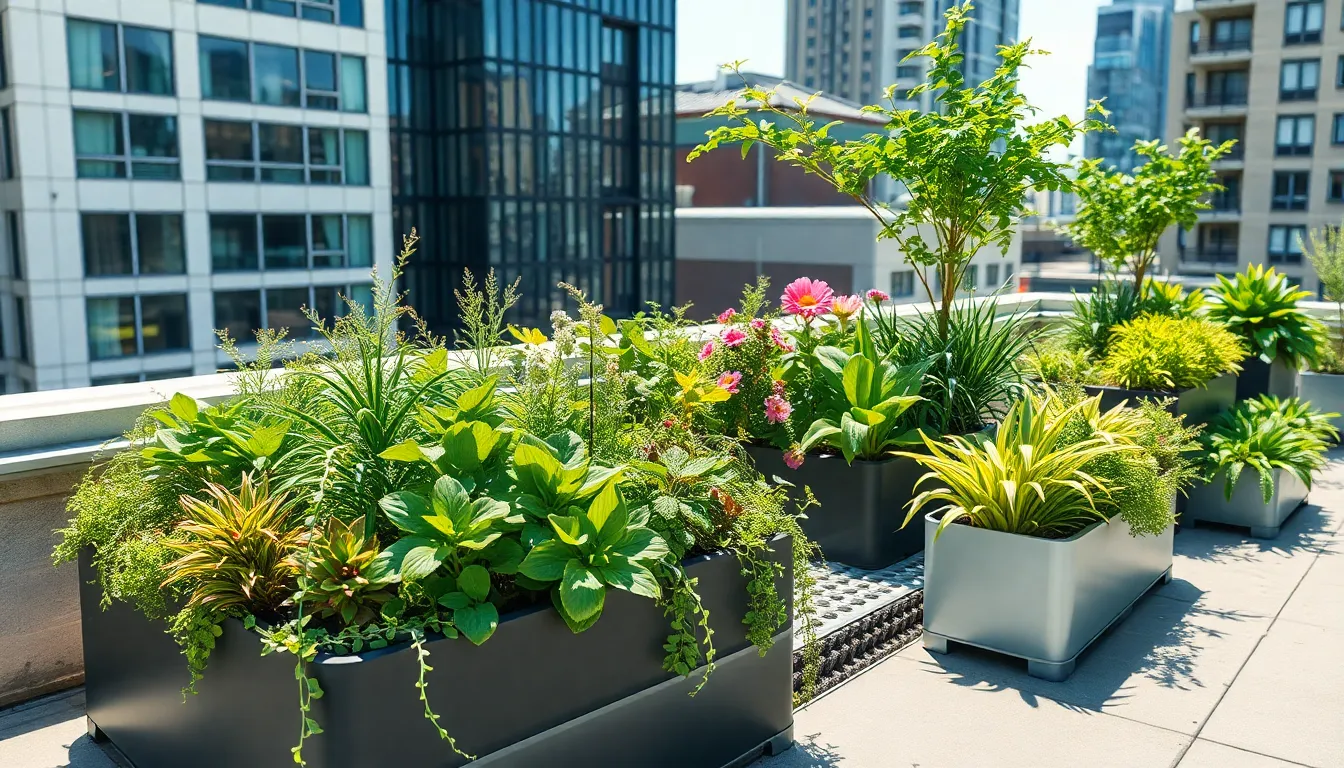
Proper water management forms the foundation of successful roof garden cultivation. We’ll explore three essential approaches that protect both your plants and building structure while maximizing water efficiency.
Install Proper Drainage Answers
Drainage layers create the first line of defense against water damage and root rot in rooftop environments. We recommend installing materials like gravel, expanded clay, or synthetic mats directly above your waterproof membrane to channel excess water away from plant roots and the roof surface.
Sloped surfaces prevent dangerous water accumulation that can compromise structural integrity. We design our roof garden beds with slight slopes directing water toward designated drains, eliminating pooling risks and potential water damage to the building.
Geotextile fabrics serve as permeable barriers between soil and drainage layers. We position these materials to prevent clogging while maintaining optimal water flow, ensuring long term system functionality without maintenance headaches.
Set Up Drip Irrigation Networks
Water efficiency reaches optimal levels through drip irrigation systems that deliver moisture directly to plant roots. We use this method to minimize evaporation and runoff, making it particularly valuable for exposed rooftop conditions.
System components require careful selection for durability and performance in harsh rooftop environments. We space emitters 12-18 inches apart using reliable tubing and incorporate pressure regulators to optimize water flow while preventing system damage.
Smart controllers revolutionize irrigation management by automatically adjusting watering schedules based on weather conditions and soil moisture levels. We integrate these sensors to reduce water waste significantly while maintaining optimal plant health.
Use Self-Watering Container Systems
Wicking beds reduce water consumption by up to 80% compared to traditional surface watering methods. We carry out these self watering systems that allow plants to draw moisture as needed from reservoirs positioned below the soil level.
Container design features built in reservoirs and specialized aeration systems that promote healthy root development. We select containers with these integrated features to prevent overwatering while ensuring consistent moisture availability for optimal plant growth.
Design Vertical Gardens and Living Walls
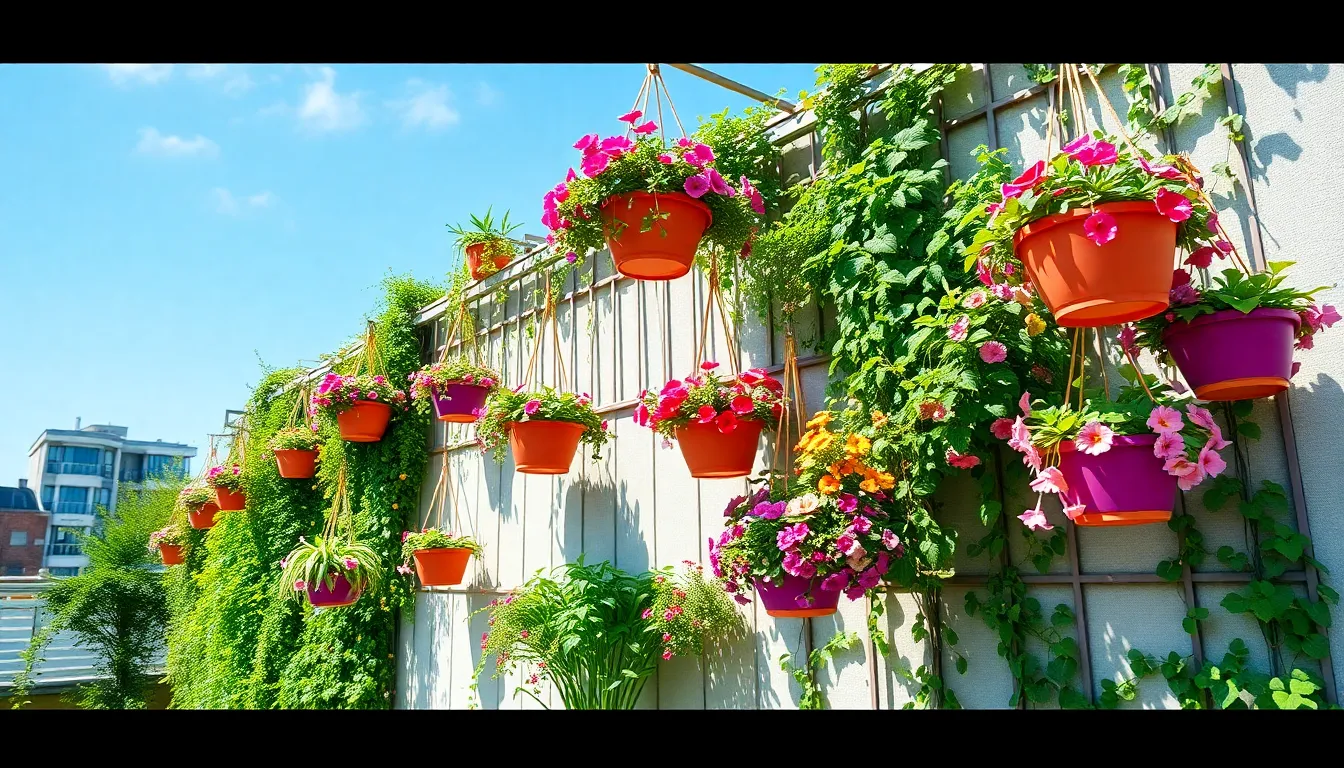
Maximizing our rooftop’s vertical space transforms ordinary walls into living masterpieces that thrive in urban environments. We’ll explore three innovative approaches that create stunning displays while efficiently using every inch of available space.
Build Trellis Systems for Climbing Plants
Wooden or metal trellises provide essential support structures that transform bare walls into verdant backdrops. We recommend installing these frameworks directly against walls or freestanding to create natural room dividers in our rooftop gardens.
Climbing vines like ivy and climbing hydrangea establish themselves quickly when planted near these support systems. These hardy species create lush coverage over time while requiring minimal maintenance once established.
Structural elements become focal points when we incorporate decorative trellis designs that complement our garden’s aesthetic. Metal options offer modern appeal and exceptional durability against weather extremes, while wooden versions provide rustic charm and natural integration with plant materials.
Install Modular Green Wall Panels
Pre-made panel systems offer effortless installation answers that require minimal construction skills or time investment. We can mount these ready-to-plant modules directly onto existing walls, creating instant green facades that thrive in challenging urban conditions.
Plant variety flexibility allows us to customize these systems with everything from drought-tolerant succulents to colorful flowering species. Each panel accommodates different plant types, enabling us to create diverse visual compositions that change seasonally.
Maintenance requirements stay remarkably low with these engineered systems since they’re specifically designed for rooftop environments. Water distribution happens evenly throughout each panel, while integrated drainage prevents root rot and water damage.
Create Hanging Garden Displays
Hanging baskets introduce three-dimensional elements that draw the eye upward and maximize our growing space exponentially. We can suspend these containers at varying heights to create layered compositions that add visual depth to flat rooftop areas.
Colorful displays emerge when we select flowering plants or vibrant foliage varieties for these elevated planters. Cascading species like trailing petunias or ivy geraniums create waterfall effects that soften hard architectural lines.
Layered planter arrangements work exceptionally well in small urban spaces where ground area is limited but vertical space is abundant. We can stack or tier these containers to accommodate more plants while maintaining easy access for watering and maintenance.
Incorporate Sustainable Energy Solutions
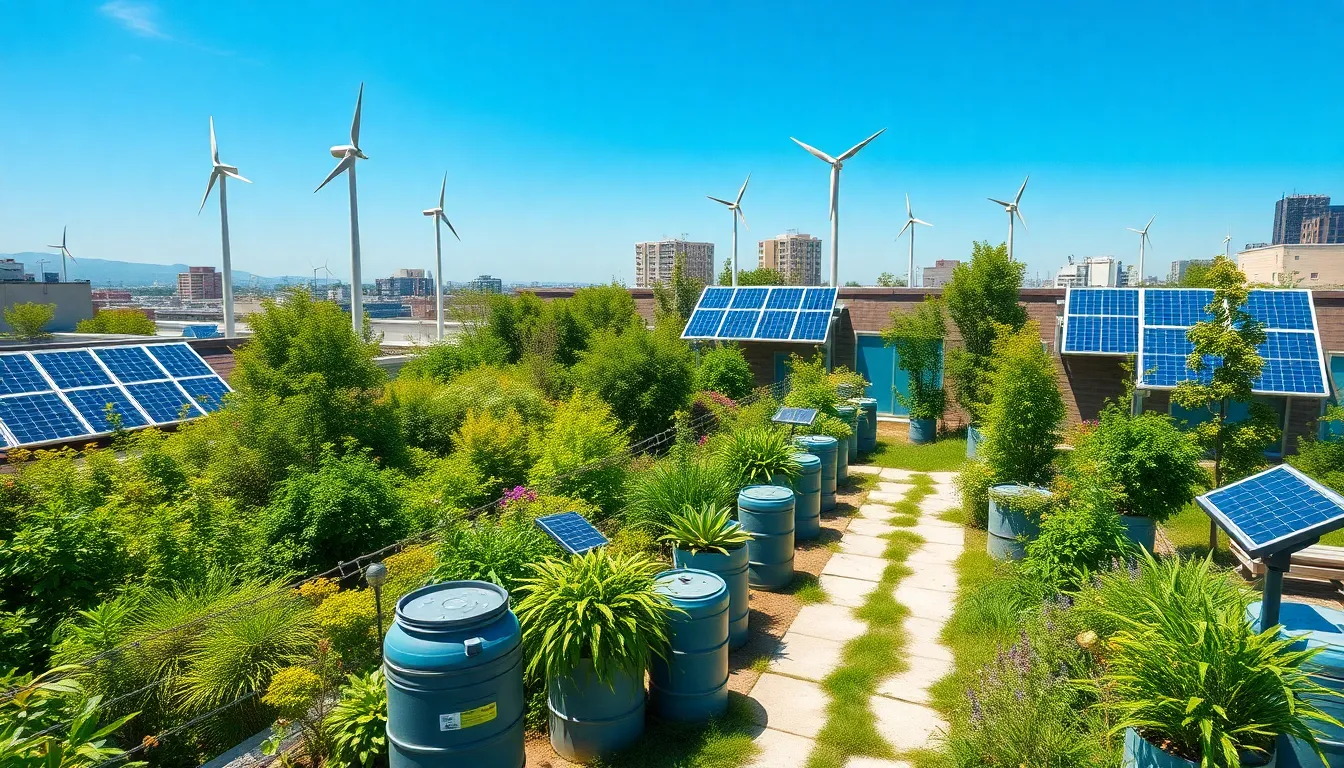
Transforming your rooftop garden into an eco-friendly space becomes even more rewarding when we integrate renewable energy technologies. These sustainable answers reduce our environmental footprint while cutting utility costs and creating self-sufficient garden ecosystems.
Add Solar-Powered Lighting Systems
Installing solar-powered lighting systems provides energy-efficient illumination that reduces reliance on grid power while lowering electricity bills. We can strategically place solar lights along pathways, around seating areas, and near focal points to create ambient lighting throughout our rooftop garden. These systems work by collecting sunlight during the day through photovoltaic panels and automatically illuminating our space after dark.
Choose LED solar lights that offer longer lifespans and brighter output compared to traditional bulb options. String lights, lanterns, and spotlights powered by solar energy create beautiful nighttime atmospheres without increasing monthly utility expenses. Many modern solar lighting systems include motion sensors and dimming features that optimize energy consumption based on actual usage patterns.
Position solar panels in areas receiving maximum sun exposure to ensure optimal charging throughout the day. We should avoid placing lights in shaded spots created by tall plants or structures, as insufficient charging leads to dim or inconsistent performance. Battery backup systems in quality solar lights provide consistent illumination even during cloudy periods.
Install Wind Turbines for Small-Scale Energy
Small wind turbines generate electricity to power garden features like irrigation systems and lighting fixtures. We can install compact vertical-axis wind turbines that capture wind from multiple directions, making them ideal for rooftop environments where wind patterns vary throughout the day. These turbines typically produce between 400 to 1,000 watts depending on wind conditions and turbine specifications.
Select wind turbines designed specifically for urban environments that operate efficiently at lower wind speeds. Rooftop installations benefit from consistent air currents found at elevated heights, with most urban areas experiencing sufficient wind speeds of 7-15 mph for effective energy generation. Modern small-scale turbines feature noise-reduction technology that minimizes sound disruption for neighboring properties.
Connect wind-generated power to battery storage systems that provide consistent energy supply during calm periods. We can integrate these systems with existing solar installations to create hybrid renewable energy answers that maximize power generation throughout varying weather conditions. Professional installation ensures proper mounting and electrical connections that comply with local building codes and safety requirements.
Use Rainwater Collection Systems
Implementing rainwater collection systems significantly reduces external water sources for irrigation while conserving water and reducing stormwater runoff. We can install gutters and downspouts that direct rainfall into storage tanks or barrels positioned strategically around our rooftop garden. These systems typically capture 0.6 gallons of water per square foot of roof surface during each inch of rainfall.
Design collection systems with first-flush diverters that redirect initial rainfall away from storage containers. This prevents contaminated water from roofing materials and debris from entering our irrigation supply. Filtering systems using screens and settling tanks improve water quality before distribution to plants through drip irrigation networks.
Calculate storage capacity based on average rainfall patterns and garden irrigation needs in your exact region. We should size our collection systems to capture sufficient water during wet periods for use during dry spells. Overflow systems prevent tank damage during heavy rainfall events while directing excess water to appropriate drainage areas rather than contributing to urban flooding.
Build Raised Beds and Container Gardens
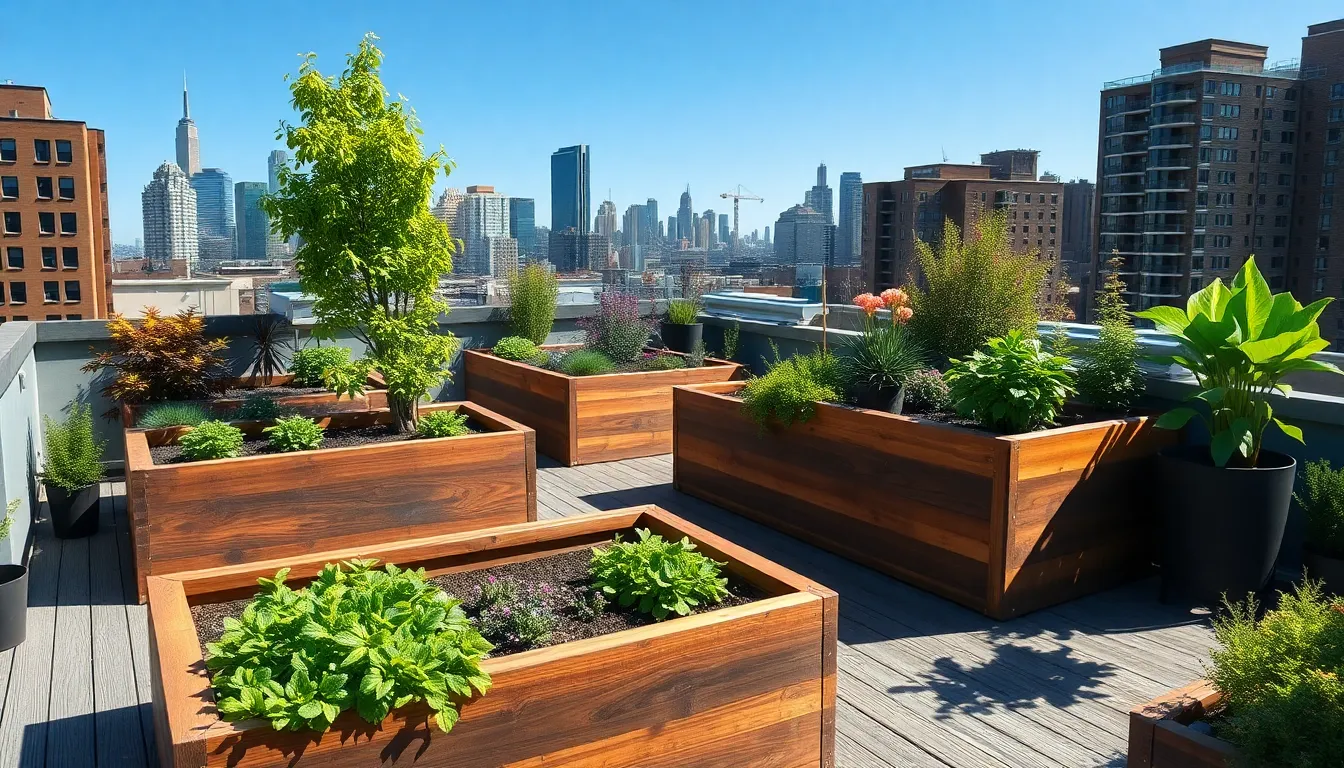
We’ve covered vertical answers and sustainable systems, so now let’s focus on the foundation of any successful roof garden. Creating structured growing spaces with raised beds and containers gives us the control we need for optimal plant growth.
Construct Lightweight Planting Boxes
Wood and recycled plastic emerge as our top material choices for rooftop planting boxes. These lightweight options minimize structural load while providing durability against weather extremes. Building with cedar or composite lumber offers natural resistance to moisture and insects without adding excessive weight to your roof structure.
Drainage becomes critical when constructing these boxes since water accumulation can damage both plants and roofing materials. We recommend drilling drainage holes every 6 inches along the bottom and incorporating raised feet to elevate boxes above the roof surface. Installing removable drainage plugs allows us to control water flow during different seasons.
Size considerations matter significantly for rooftop installations since larger boxes distribute weight more evenly across roof joists. Rectangular boxes measuring 4 feet by 8 feet provide ample growing space while maintaining manageable weight distribution. Corner reinforcements with metal brackets ensure structural integrity against wind stress and soil expansion.
Choose Appropriate Container Sizes
Container selection directly impacts both plant health and maintenance requirements in rooftop environments. Large containers retain moisture longer and provide stable root zones for substantial plants like dwarf fruit trees or ornamental grasses. We suggest containers with minimum capacities of 20 gallons for permanent plantings and 5 gallons for seasonal vegetables.
Space optimization becomes essential when selecting container dimensions for limited rooftop areas. Rectangular planters use corner spaces more efficiently than round pots while providing greater soil volume for root development. Containers measuring 24 inches wide by 36 inches long offer versatile planting options without overwhelming smaller rooftops.
Weight considerations require careful calculation since soil and water add substantial mass to container gardens. Lightweight containers made from fiberglass or high density polyethylene reduce overall load while maintaining durability. We calculate approximately 100 pounds per cubic foot of saturated soil when determining total container weight for structural planning.
Layer Soil and Drainage Materials
Specialized rooftop soil mixes provide superior drainage and reduced weight compared to traditional garden soil. These engineered growing media typically contain expanded shale, compost, and lightweight aggregates that drain efficiently while retaining essential nutrients. We recommend soil depths of 6 inches for groundcovers, 12 inches for perennials, and 24 inches for shrubs and small trees.
Drainage layers prevent waterlogging and root rot in container environments where natural drainage doesn’t exist. Gravel or expanded clay pellets create effective drainage zones when layered 2 to 4 inches deep at container bottoms. Geotextile fabric placed over drainage materials prevents soil migration while maintaining water flow.
Soil amendments enhance growing conditions for rooftop plants facing extreme temperature fluctuations and wind exposure. Perlite additions improve aeration and drainage while coconut coir retains moisture during hot periods. We incorporate slow release fertilizers directly into soil mixes to reduce maintenance requirements and ensure consistent nutrient availability throughout growing seasons.
Add Privacy Screens and Windbreaks
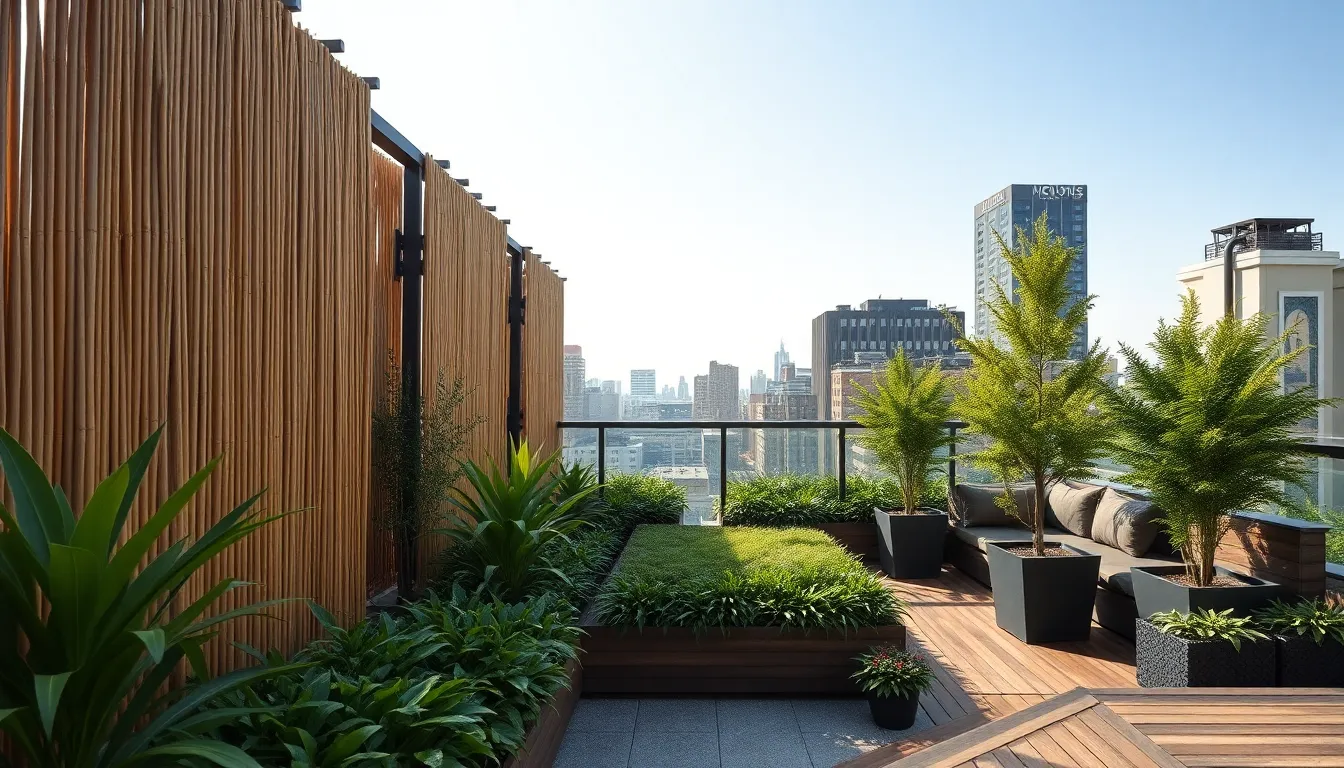
Privacy screens and windbreaks transform rooftop gardens into secluded retreats while protecting plants from harsh weather conditions. We can create intimate outdoor spaces that shield us from prying eyes and damaging winds.
Install Bamboo or Reed Screening
Bamboo screening offers an affordable natural solution that blocks unwanted views while maintaining an organic aesthetic. These lightweight materials install easily on rooftops without adding important structural weight. We can choose from various heights and densities to match our exact privacy needs.
Reed screening provides excellent wind resistance due to its flexible nature that bends rather than breaks. Most bamboo and reed panels come pre-rolled for quick installation along railings or fence posts. Natural materials like these age gracefully and develop an attractive weathered appearance over time.
Maintenance requirements stay minimal since bamboo and reed screening resist moisture and UV damage. We simply need to secure panels properly to prevent wind displacement and occasionally replace sections that show excessive wear.
Plant Dense Shrub Barriers
Dense shrub barriers create living windbreaks that provide privacy while adding natural beauty to our rooftop space. Hawthorn shrubs grow thick and thorny, making them excellent choices for creating impenetrable screens. These hardy plants tolerate rooftop conditions and require minimal water once established.
Juniper varieties offer year round coverage with their evergreen foliage and compact growth habits. We can plant these shrubs in containers or raised beds to create flexible privacy answers. Their dense branching structure effectively blocks wind while supporting local wildlife.
Strategic placement of shrub barriers allows us to create microclimates within our garden space. Plants positioned behind these natural windbreaks experience less stress and require less frequent watering. Dense foliage also filters dust and pollution from urban environments.
Use Decorative Panel Systems
Decorative panel systems provide stylish privacy answers that complement modern rooftop designs. Wood panels offer warmth and natural texture while metal options deliver contemporary industrial aesthetics. Composite materials combine durability with low maintenance requirements.
Custom panel configurations allow us to match existing architectural elements and personal style preferences. We can incorporate geometric patterns, laser cut designs, or traditional screening motifs. These systems often include modular components that expand or reconfigure as our needs change.
Installation flexibility makes decorative panels suitable for various rooftop layouts and structural constraints. Most systems mount to existing railings or freestanding posts without requiring permanent modifications. Weather resistant finishes protect against rain, snow, and intense UV exposure while maintaining their appearance for years.
Include Water Features and Focal Points

Water elements and eye-catching focal points transform ordinary rooftop spaces into captivating outdoor sanctuaries. These features create natural gathering spots that draw attention and establish visual hierarchy throughout your garden design.
Install Small Fountains or Water Gardens
Installing small fountains brings both visual appeal and soothing sounds to your rooftop retreat. Modern fountains with sleek sheet waterfall designs complement contemporary architecture, while naturalistic styles blend seamlessly with surrounding plantings. We recommend positioning fountains near seating areas to maximize their calming auditory benefits.
Water gardens offer deeper tranquility through reflecting pools that create a sense of expansive space. Fish ponds introduce vibrant movement with colorful koi or goldfish, adding life and activity to your rooftop environment. Shallow reflecting pools provide mirror-like surfaces that capture sky reflections and amplify natural light throughout the garden.
Artificial streams create the illusion of natural brooks flowing through your rooftop industry. These features enhance the natural ambiance while requiring minimal water circulation systems. Rock bubblers provide subtle water movement and gentle sounds without overwhelming smaller spaces or dominating the overall design aesthetic.
Create Sculptural Elements
Statues and art pieces serve as powerful focal points that inject personality into your rooftop garden space. We suggest selecting weather-resistant materials like bronze, stone, or treated metals that withstand rooftop conditions. Position sculptures at pathway intersections or sight lines to guide visitor movement through the garden.
Contemporary metal sculptures complement modern rooftop designs while classical statuary suits traditional garden themes. Large planters can double as sculptural elements when crafted from distinctive materials or shaped into unique forms. We recommend balancing sculptural scale with available space to avoid overwhelming intimate rooftop areas.
Interactive art pieces encourage engagement and create memorable experiences for garden visitors. Wind sculptures harness rooftop breezes to create kinetic displays that change throughout the day. These ever-changing elements add constant visual interest while celebrating the unique environmental conditions of elevated gardens.
Add Artistic Planters and Containers
Custom planters crafted from cedar or metal materials provide distinctive frameworks for plant displays while adding architectural interest. We recommend selecting materials that complement your building’s exterior finishes for cohesive design integration. Large custom containers create substantial visual impact while supporting bigger plants that require extensive root systems.
Vertical planters maximize growing space through wall-mounted systems and trellises that use vertical surfaces. These installations create lush green environments without consuming valuable floor space. We suggest combining different container sizes and heights to establish ever-changing compositions that engage viewers from multiple angles.
Decorative container groupings establish planting zones while contributing artistic elements to your rooftop design. Mixed material combinations like concrete paired with wood create textural contrast and visual depth. We recommend using containers with built-in water reservoirs to reduce maintenance demands while ensuring consistent plant hydration in challenging rooftop conditions.
Design Pathways and Flooring Solutions
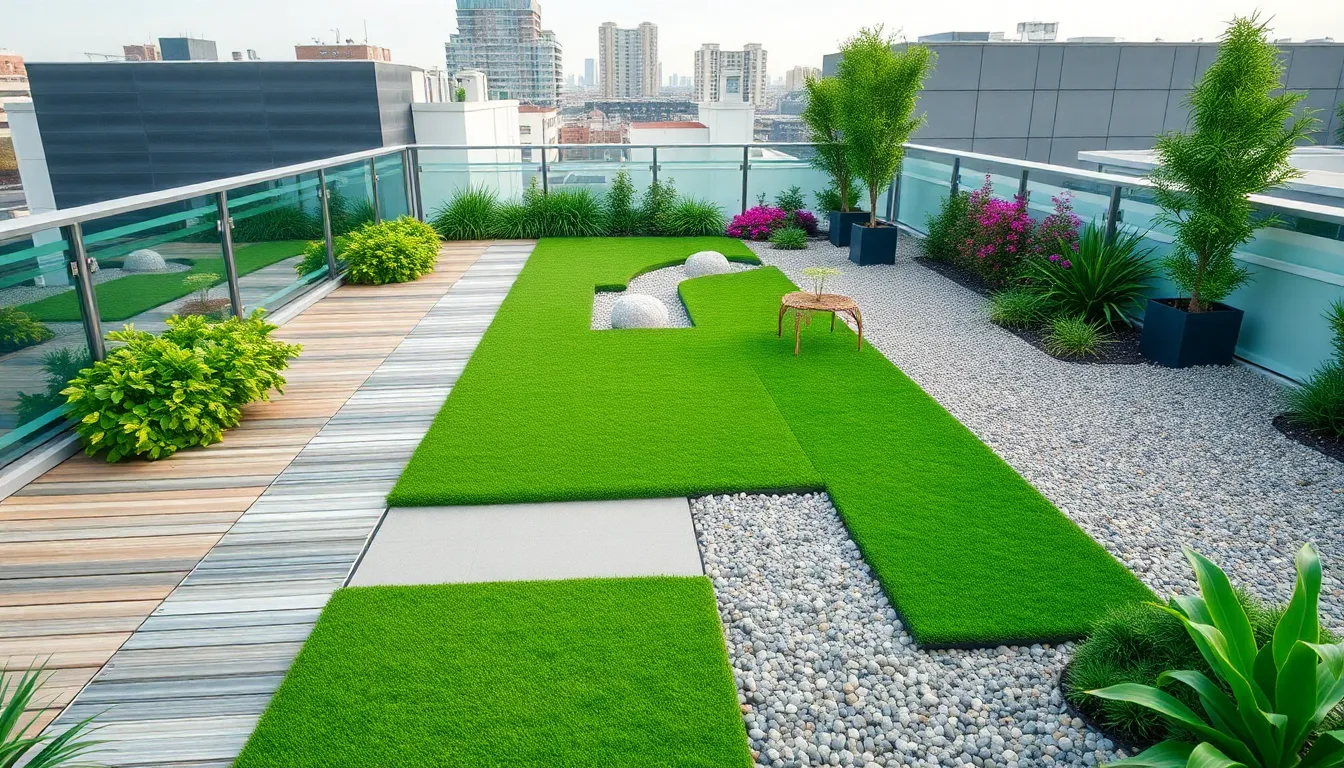
Creating functional pathways transforms your rooftop garden into an accessible and visually appealing space. Strategic flooring choices provide both practical walkways and attractive surfaces that complement your garden design.
Use Interlocking Deck Tiles
Interlocking deck tiles offer the most versatile flooring solution for rooftop gardens. We can install these tiles without professional assistance since they simply snap together over existing surfaces. Various materials including composite wood, stone, and plastic provide options to match any design aesthetic.
Rearranging these tiles becomes effortless when you want to modify your garden layout. The interlocking system creates a stable walking surface that distributes weight evenly across your rooftop structure. Different tile sizes and patterns allow us to customize pathways that guide visitors through planting areas while protecting the underlying roof membrane.
Install Artificial Turf Sections
Artificial turf sections create comfortable seating areas without the maintenance requirements of natural grass. We recommend this low maintenance option for zones where you’ll place outdoor furniture or want barefoot friendly surfaces. Modern synthetic grass options closely mimic real turf appearance while withstanding harsh rooftop conditions.
Installing turf in designated sections provides soft contrast against harder flooring materials. The synthetic material drains water efficiently while offering cushioned surfaces for relaxation areas. Different pile heights and textures let us create varied zones throughout the rooftop garden space.
Create Gravel or Stone Walkways
Gravel or stone walkways provide natural aesthetic appeal while solving drainage challenges. We can design permeable pathways that allow water to flow through rather than pooling on surfaces. Natural materials complement planted areas and create seamless transitions between garden zones.
Stone options range from decorative pebbles to larger river rocks depending on your desired visual impact. The permeable nature of these materials prevents water damage while creating attractive borders around planting areas. Installing these walkways requires minimal maintenance once established and provides excellent drainage answers for rooftop environments.
Conclusion
Creating your dream rooftop garden doesn’t have to be overwhelming when you break it down into manageable steps. We’ve covered everything from plant selection and structural considerations to energy answers and aesthetic enhancements that’ll transform your urban space into a thriving oasis.
The key to success lies in planning thoughtfully and choosing elements that work together harmoniously. Whether you’re starting with a small balcony or have an expansive rooftop to work with we believe these strategies will help you create a space that’s both beautiful and functional.
Remember that rooftop gardening is an ongoing journey of discovery and refinement. Start with the basics and gradually add features as you gain experience and confidence. Your rooftop garden will evolve into a personalized retreat that provides years of enjoyment while adding value to your property.
Frequently Asked Questions
What are the main benefits of creating a rooftop garden?
Rooftop gardens offer numerous advantages including reduced energy costs through natural insulation, creation of a peaceful urban retreat, and increased property value. They optimize unused space in cities, provide fresh air and greenery, and can help reduce stormwater runoff. Additionally, they create habitats for wildlife and offer opportunities for growing your own food or beautiful flowers.
Which plants work best for rooftop gardens?
The best rooftop plants are wind-resistant and drought-tolerant varieties. Ornamental grasses, evergreen shrubs, and low-growing perennials create natural windbreaks. Succulents, native wildflowers, and heat-loving plants thrive in full sun conditions common on rooftops. Consider climbing vines like ivy for vertical spaces and choose plants that can withstand extreme weather conditions.
How do I ensure proper drainage in my rooftop garden?
Install drainage layers using gravel and geotextile fabrics to prevent water damage and root rot. Create sloped surfaces directing excess water toward designated drains to minimize pooling. Use containers with drainage holes and consider removable plugs for water flow management. Proper drainage is essential to prevent structural damage and ensure plant health.
What irrigation systems work best for rooftops?
Drip irrigation systems are ideal as they deliver water directly to plant roots, maximizing efficiency and reducing waste. Smart controllers can adjust watering schedules based on weather conditions and soil moisture levels. Self-watering container systems like wicking beds reduce water consumption while ensuring consistent moisture. Rainwater collection systems provide sustainable irrigation options.
How can I maximize space in a small rooftop garden?
Utilize vertical gardening techniques with trellis systems, living walls, and hanging gardens to create layered compositions. Install modular green wall panels for easy customization. Use built-in benches or planters that double as seating. Consider container gardens and raised beds that can be arranged efficiently while maintaining proper weight distribution for safety.
What materials should I use for rooftop garden structures?
Choose lightweight, weather-resistant materials like recycled plastic, aluminum, or treated wood for raised beds and planters. Use interlocking deck tiles for flooring, artificial turf for seating areas, and bamboo screening for privacy. Select durable outdoor furniture made from materials that can withstand harsh rooftop conditions including wind, sun, and temperature fluctuations.
How do I create privacy and wind protection on my rooftop?
Install bamboo or reed screening for affordable, natural privacy barriers. Plant dense shrub barriers using hawthorn, juniper, or similar wind-resistant species. Consider decorative panel systems that can be customized to match your design aesthetic. Strategic placement of tall planters and trellises can create intimate conversation nooks while blocking wind.
Can I incorporate sustainable energy solutions in my rooftop garden?
Yes, solar-powered lighting systems provide energy-efficient illumination throughout your garden. Small wind turbines can power irrigation systems and other garden features. Solar panels can be integrated into pergola designs or used as standalone features. These renewable energy solutions reduce environmental impact and utility costs while enhancing garden functionality.
What type of soil should I use for rooftop containers?
Use specialized rooftop soil mixes that provide superior drainage and reduced weight compared to regular garden soil. Layer soil with drainage materials to prevent waterlogging. Consider soil amendments to enhance growing conditions for plants facing extreme weather. Lightweight potting mixes with good water retention and drainage properties work best for container gardening.
How do I add visual interest to my rooftop garden?
Incorporate water features like small fountains or water gardens near seating areas for tranquil sounds. Add sculptural elements, statues, or interactive art pieces as focal points. Use artistic planters and containers that complement your building’s exterior. Create pathways with gravel, stone, or decorative tiles to define different garden zones and enhance overall aesthetics.

